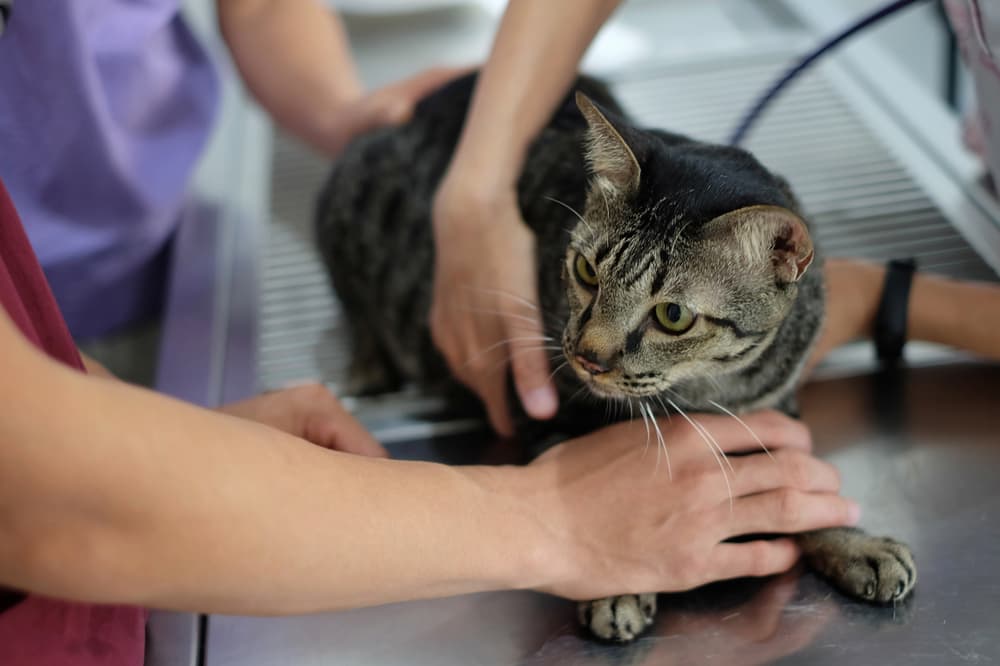Can Cats Have Allergies?

Seasonal allergies can smack us right in the nose in spring when pollen is in the air or in fall when mold spores replace the pollen. It’s not uncommon for certain allergies to create respiratory problems, too. Food allergies and contact allergies may also cause a variety of physical symptoms in people, such as itchiness.
Cats can certainly have itchy skin, and many will also cough or sneeze from time to time. This begs the question: can cats have allergies? Let’s take a closer look.
Can Cats Have Allergies?
The short answer is yes, cats can have allergies. Allergies are an inflammatory response to a specific stimulus, and this delightful experience isn’t restricted to humans alone. That said, cats don’t necessarily experience allergies in the exact same way humans do, but many people know how uncomfortable it can be to have something seemingly innocuous (or even invisible) trigger a physical reaction like this.
According to Dr. Sarrah Hoppers, assistant professor of dermatology at the Colorado State University College of Veterinary Medicine and Biomedical Sciences, allergies in cats generally first surface when the animals are young, specifically between ages 1 and 3.
“Some studies have shown that Maine Coon, Abyssinian, Siamese, Persians, and Himalayan cats are predisposed to developing allergies,” Dr. Hoppers adds, “but we should be careful interpreting that type of information, as these might not represent a true breed predisposition but rather a regional popularity of certain breeds.”
Types of allergies in cats include:
- Food allergies
- Environmental allergies
- Allergic bronchitis (feline asthma)
- Flea allergies
- Contact allergies
What Causes Allergies in Cats?

Many things can trigger allergies in cats. Here is a look at common triggers, broken down by allergy type.
Food allergies
Cats can be allergic to specific ingredients in their food. “In the vast majority of cases of food allergies in cats and dogs, it is the protein source in the diet that causes the allergy,” Dr. Hoppers says.
The most common proteins that cause allergies in cats are chicken, beef, and fish, she adds. While more rare, other ingredients like wheat and corn can sometimes be the source of an allergy.
Environmental allergies
With the exception of flea allergies, most other allergies in cats are triggered by environmental factors, says Dr. Bruce Kornreich, the director of the Cornell Feline Health Center at the Cornell University College of Veterinary Medicine. These are more commonly referred to as seasonal allergies because most of these allergens are typically prevalent during a specific time of year.
“In the spring, it’s trees and grass growing. Molds are present in fall. And dust mites might be more prevalent in winter because the heat is turned on, and they’re in the duct work of the house, so they get stirred up into the air, and cats breathe them in,” Dr. Kornreich says.
Allergic bronchitis
Airborne substances, such as cigarette smoke or strongly scented products like candles or even kitty litter dust, can trigger allergic bronchitis in cats, also known as feline asthma. “Feline asthma is a common problem,” says Dr. Jessica Bell, an assistant professor of community practice at Washington State University College of Veterinary Medicine. Dr. Bell says smoke in the air from wildfires where she lives in the Northwest can trigger an asthmatic reaction in cats.
Flea allergies
The presence of fleas, of course, makes cats itchy, but it’s also possible that some cats are allergic to fleas, Dr. Kornreich says. More specifically, the proteins in flea saliva trigger a reaction in allergic cats when they get bit.
If a cat is allergic to fleas, they might be allergic to other parasites, Dr. Bell says. Parasite control is one of the most important strategies for allergy management.
Contact allergies
Though it is rare compared to the other types of allergies discussed so far, cats can experience contact allergies. For example, a cat can be allergic to certain cleaning products used on countertops or other surfaces they come into contact with, Dr Kornreich says.
Some shampoos may also cause allergic dermatitis in cats, Dr. Bell adds.
Allergy Symptoms in Cats

Symptoms of allergies in cats typically fall into three buckets: dermatological, respiratory, and gastrointestinal (GI).
The primary dermatological symptom of most types of allergies is itching, Dr. Hoppers says, but this leads to other behaviors that cause additional problems.
“Itching is usually the most prevalent symptom, and this leads to the cat over-grooming, which can look like excessive licking, chewing, and/or pulling out tufts of hair,” she says. “This self-traumatization often causes open and/or crusted skin lesions to develop, and secondary bacterial skin infections are relatively common.”
Treating secondary infections is just as important as dealing with the initial symptoms of the allergy, Dr. Kornreich says. Without doing so, your cat may end up in a cycle where the allergy is no longer bothering them, but the secondary infection causes itching that may lead to another infection, and so on.
While respiratory symptoms may not be as prevalent or common as dermatological symptoms for many types of allergies in cats, they manifest more frequently when it comes to inhaled allergens. Respiratory symptoms in cats due to allergies can include coughing and wheezing.
GI symptoms of allergies in cats include vomiting and diarrhea, says Dr. Bell. These symptoms can occur with diet-related allergens, though food allergy symptoms in cats also include itchiness that can occur anywhere on the body. Sometimes a cat’s head and neck are impacted by itchiness from food allergies in particular, Dr. Hoppers says.
Diagnosing Allergies in Cats

Diagnosing allergies in cats can be a challenging and potentially lengthy process for pet parents and medical professionals. This is because many of the symptoms associated with feline allergies are symptoms of other conditions as well.
The process for diagnosing non-food allergies in cats starts with ruling out things like mites, ticks, fleas, and fungal skin diseases, Dr. Kornreich says.
Once these triggers are ruled out, a veterinary dermatologist can conduct an intradermal skin test on your cat. “It involves injecting very small amounts of various allergens under the skin as you watch to see if there’s an inflammatory reaction,” Dr. Kornreich says.
There’s also a blood test that looks for a specific antibody called immunoglobulin E (IgE), which Dr. Kornreich says can be somewhat helpful for diagnosing environmental allergies in cats, but it’s not as reliable as the skin test.
If your veterinarian suspects a food allergy, the best way to confirm this is to try and eliminate the allergen from your cat’s diet. The preferred method of doing this is giving the cat a hydrolyzed diet, in which protein chains are broken into smaller pieces so that the body doesn’t recognize the protein that may be causing the allergy, Dr. Bell says.
The cat should be on this diet for about 12 weeks to get an appropriate sense of whether it’s working, she says. During that time, no other sources of food—including treats, food that’s meant for another cat in the house, or table scraps—can be given to the cat or else the process must start over again. This includes medications, such as preventatives, that have flavorings in them. Check with your veterinarian before discontinuing any medications.
An alternative to a hydrolyzed diet that pet parents can perhaps more easily attempt on their own involves feeding a cat a protein that he has never been exposed to before (a novel protein) for a similar period of time and with the same restrictions on other types and sources of food, Dr. Bell says. However, if you wish to do this, it’s critical that you closely review the food label to ensure it’s limited in carbohydrates and doesn’t contain any fillers or other ingredients that come from other protein sources.
For all of these reasons, it’s wise to work alongside a veterinary professional when trying to identify what’s triggering a food allergy in cats.
Treating Allergies in Cats

There are a variety of ways to treat allergy symptoms in cats with medications. The best option depends on the cat and the severity of the problem. “Allergy medications should be prescribed and monitored by a veterinarian, and home remedies are typically not effective or recommended,” Dr. Hoppers says.
Antihistamines are among the most common treatments for allergies in cats, Dr. Kornreich says. Veterinarians may also try cyclosporine for allergic dermatitis or a corticosteroid, though the latter comes with potential negative side effects.
“The biggest [side effect] is diabetes, and in some cases, if the cat has other problems like heart disease, [steroids] can worsen them,” he says. “So lifestyle changes, along with antihistamines and omega-3 fatty acids, might be worth trying first.”
Additionally, like humans, cats may undergo allergen-specific immunotherapy, Dr. Kornreich says, during which the cat is intermittently given small injections of the potentially offending allergen to desensitize them.
Preventing Allergies in Cats
If a food allergy is strongly suspected, the best method of prevention is formulating a diet for the cat that removes the offending ingredient, as outlined above.
Keeping all pets in the home on year-round parasite prevention is the best way to prevent flea allergies.
Many other allergies in cats, including ones coming from specific environmental sources, may be more difficult to completely prevent. However, Dr. Kornreich says regularly changing the air filters in your house, cleaning out your ducts, and deep cleaning in general can all help rid your cat’s space of potentially offending allergens.
And if prevention isn’t possible, treatment is your best course of action. The earlier you start that process, the better, Dr. Hoppers says. “The single most important thing a pet parent can do is intervene in the allergic process under the guidance of a veterinarian or veterinary dermatologist as early in life as possible,” she says. “When left undiagnosed and untreated, allergy symptoms tend to become more severe as animals age, and they can become more difficult to treat as a result. Identifying the problem and starting a treatment protocol early presents the best chance for success and improving quality of life.”









